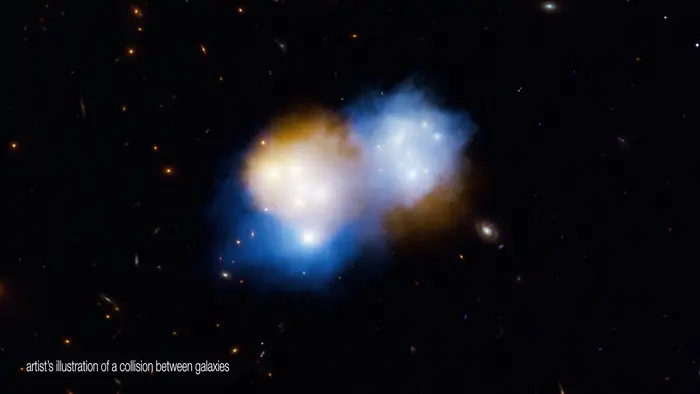Astronomers have captured a rare glimpse into the behavior of dark matter during a massive collision between two galaxy clusters billions of light-years from Earth. The new observations show dark matter and normal matter decoupling and moving at different speeds, providing fresh insights into the nature of this mysterious substance that makes up most of the universe’s mass.
A Cosmic Game of Cat and Mouse
The collision, involving two clusters collectively known as MACS J0018.5+1626, offers a unique perspective on the interaction between dark and normal matter. As the clusters plowed through each other, their vast clouds of dark matter sped ahead of the normal matter, which became bogged down by electromagnetic interactions.
Emily Silich, the study’s lead author and a graduate student at Caltech, likens the event to “a massive collision between multiple dump trucks carrying sand.” She explains, “The dark matter is like the sand and flies ahead.”
This separation occurs because dark matter only interacts through gravity, while normal matter also experiences electromagnetic forces. During the collision, the normal matter—primarily hot gas between galaxies—became turbulent and superheated, slowing it down. Meanwhile, the dark matter continued its journey unimpeded.
New Tools for Probing the Invisible
To measure the speed of normal matter in the cluster, researchers used a technique called the kinetic Sunyaev-Zel’dovich (SZ) effect. This method detects how photons from the early universe scatter off electrons in hot gas, revealing the gas’s motion.
Jack Sayers, research professor of physics at Caltech and the study’s principal investigator, notes the unique perspective offered by MACS J0018.5+1626’s orientation. “It’s more like we are on the straightaway with a radar gun, standing in front of a car as it comes at us and are able to obtain its speed,” he says.
The team combined data from multiple observatories, including the Caltech Submillimeter Observatory, the W.M. Keck Observatory, NASA’s Chandra X-ray Observatory, and the Hubble Space Telescope. This comprehensive approach allowed them to map out the velocities of both dark and normal matter, providing the first direct probe of their decoupling during a cluster collision.
Why It Matters
This research opens new avenues for studying dark matter, which remains one of the biggest mysteries in modern physics. By directly observing how dark matter behaves differently from normal matter during cosmic collisions, scientists can refine their theories and potentially develop new methods for detecting and understanding this elusive substance.
The findings could have far-reaching implications for our understanding of the universe’s structure and evolution. As galaxy clusters are among the largest structures in the cosmos, studying their collisions provides valuable insights into the fundamental laws governing our universe.
Looking ahead, researchers hope to apply similar techniques to other cluster collisions, building a more comprehensive picture of dark matter’s behavior. This could lead to breakthroughs in fields ranging from cosmology to particle physics, potentially reshaping our understanding of the universe’s composition and history.
As Sayers reflects, “We hope this leads to a whole new way to study dark matter in clusters.” With each new observation, we edge closer to unraveling the secrets of this invisible cosmic dance.


